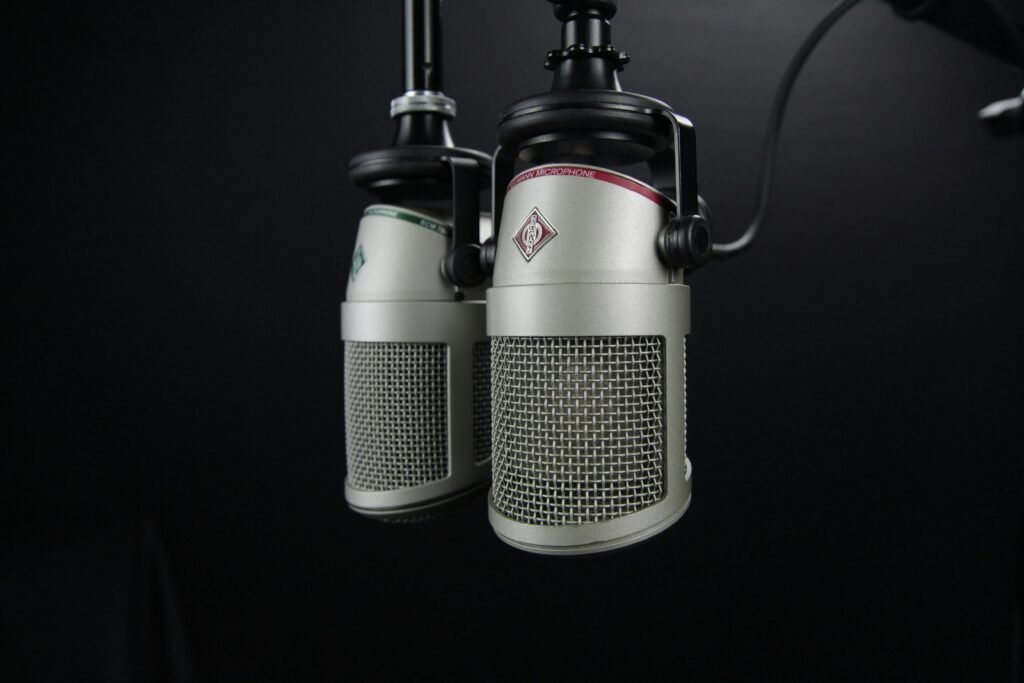
Vocals are a big deal in any song. They carry the emotion and the story. When they sound right, the whole track jumps out. In this guide we’ll focus on the lead vocal only (backing parts can wait for another day). If you can make the lead sound full, clear, and professional, the rest of the mix will follow.
You’ll learn how to choose the right microphone for vocals, use free VST plugins, and apply simple editing and mixing moves that add punch and polish.
Here are the main steps on how to make vocals sound professional:
1. Recording Vocals the Right Way (microphone for vocals, how to record vocals at home)
Choosing a mic is the first big challenge. High-end studio models can cost over $5,000, but a good take on a budget mic can still sound great. Even the best mic can’t fix a bad recording.
Once you know the basics of room acoustics (keep echoes low) and you’ve picked an affordable mic like the RØDE NT1, you’re ready to track:
- Set your input gain so peaks never hit the red in your DAW.
- Stand 8–10 inches (20–25 cm) from the mic. If you get too close, you’ll add muddy lows (even though that’s sometimes desirable) and mouth clicks.
- Use a pop filter to stop harsh “P” and “B” blasts. It’s cheap and it works. Producers are arguing if using a pop filter helps vocals or if it’s making them sound worse, but for beginners it’s a way to go.
These simple habits give you a clean vocal ready for mixing. Later you can add EQ, compression and even free VST plugins to make the voice sound fuller.
Click here to get your RØDE NT1 on Amazon
2. Using EQ (editing vocals, mixing vocals)
Once the take is clean, EQ is your first mix tool. Trust your ears. Skip “one-click” vocal presets because every singer, mic and room is different.
Step 1: High-pass filter
Cut low rumble before it muddies the mix. One voice doesn’t need anything below 300 Hz while another keeps its character down to 120 Hz. Sweep up until the vocal starts to thin, then back off a little.
Step 2: Problem cuts
Boxy room rings and echoes often sit between 700 Hz and 3 kHz. Find them and dip 2–5 dB with a narrow Q. Small cuts keep the voice alive. Don’t carve too much, you might make the vocal lifeless.
Step 3: Add air
If the vocal sounds dull, lift 8–12 kHz by 2–3 dB to keep vocal present in the mix.
Use these three moves as a starting point. When it sounds right to you, move on to compression, de-essing and any free VST plugins you’ll use to thicken the track.
3. Applying Compression (vocal compression tips, mixing vocals)
After you’ve cleaned the track with EQ, compression sets the overall loudness and evens out the performance so the vocal feels consistently “in front.”
Most compressors, including the stock plugin in every DAW, share four core controls: ratio, threshold, attack and release.
Ratio
This determines how much dynamic freedom the singer keeps.
- 8 : 1 = heavy, almost brick-wall control—great for aggressive genres but risks a “squeezed” sound.
- 2 : 1 = gentle, musical compression that still lets the vocal breathe.
There’s no universal best setting; let the style of the song and your ears decide.
Threshold
The point (in dB) where compression starts to kick in. The lower you pull the threshold, the more often—and the harder—the compressor works. Beginners often set it too low, crushing the vocal and killing its life, so go easy.
Attack & Release
These two scare newcomers because they seem abstract, yet they’re simply timing controls:
- Attack is how long (in milliseconds) the compressor waits to reach full gain reduction after the signal crosses the threshold.
- Short attack (= fast) clamps transients, reduces punch and can feel aggressive.
- Longer attack (15–30 ms) lets initial consonants pop, preserving energy and excitement.
- Release is how long the compressor keeps squeezing before it lets go and returns to zero reduction.
- If you’re unsure, park it between 150–250 ms; that window sounds natural on most vocals.
Finish by raising make-up gain until the processed vocal matches or slightly exceeds its bypass level—loud enough to sit forward, but not so loud that it fights the mix. Done right, compression delivers a smooth, present vocal that’s ready for de-essing, saturation, and other thickening vocal tricks.
Click here for more in-depht compression guide by HomeStudioToday (good for beginners)
4. Taming Sibilance with a De-Esser (de-esser plugin, remove sibilance)
Now the vocal sounds clear and up-front, but heavy compression can make “S,” “SH,” and “T” noises jump out. A de-esser fixes that:
- Put the de-esser after the compressor.
- Sweep the target band (5–8 kHz) until the meter moves only on the sharp “S” sounds.
- Lower the threshold just enough so the hiss drops back into the mix. The s-sounds should still be clear—just not louder than the words around them.
Use a light touch. Done right, de-essing smooths the top end and leaves the vocal sounding polished and easy to listen to.
5. Adding Color (free VST plugin, thickening vocals)
With EQ, compression and de-essing in place, you have a clean, balanced track. The next step is to give the vocal extra character. A popular method is to add a touch of harmonic saturation—a very mild form of distortion. In context, it won’t sound like obvious fuzz; instead it makes the voice feel thicker, meatier and more three-dimensional.
I recommend the Dimension+ free VST plugin. Dimension+ lets you pick among three color modes and dial in just the right amount via its Color knob. A subtle color setting usually adds depth without audible distortion. Comparable saturation plugins can cost well over $100, so for beginners—or anyone on a budget—Dimension+ is a priceless find that’s easy to use.
👉 Download Dimension+ here (free): www.resonastudio.com/dimension-plus-free
Add it after your dynamics processing, listen in context with the full mix, and stop turning the knob as soon as the vocal steps forward in a pleasant, “full-bodied” way. Less is more; you’re aiming for density, not distortion.
6. Adding Delay & Reverb (reverb for vocals, delay settings)
Delay is optional—decide case-by-case whether the song benefits from echoes or slapback, so we’ll keep that part brief. The next step that most mixes do need is reverb.
A well-set reverb gives your vocal a sense of space; it’s not only about “filling gaps.” Done right, reverb actually helps the voice stand out against a dense arrangement packed with instruments.
- Start with hall or plate reverbs. Both are included free in virtually every DAW, so audition the stock plugins first.
- Experiment with presets, then tweak. Adjust decay, pre-delay and wet level until the vocal sits naturally.
- Less is (usually) more. New mixers often drown vocals in reverb. Sometimes a big, lush tail is perfect, but more often a barely audible wash—just enough that the average listener can’t pinpoint it—is what lets the vocal “swim” in the mix without a discernible echo.
Keep an ear on clarity: the goal is depth and cohesion, not a distant, muddy lead. Once reverb feels integrated and the track still sounds upfront, you’ve nailed it.
7. Conclusion on “How to make vocals sound professional”
We’ve now walked through the essentials of making your vocals sound professional. The biggest lesson: be creative, trust your God-given ears and avoid cookie-cutter “instant” solutions. Music production is a journey, and recording plus mixing vocals is one of its most joyful stops.
Listen closely to every take, make tiny tweaks until the sound truly serves your song, and remember that each project is its own story—presets and rigid templates rarely fit them all. Keep soaking up music you love, borrow ideas, chase the tones that move you, experiment without fear…and enjoy the ride.
Happy mixing, and God bless! 🎙️



